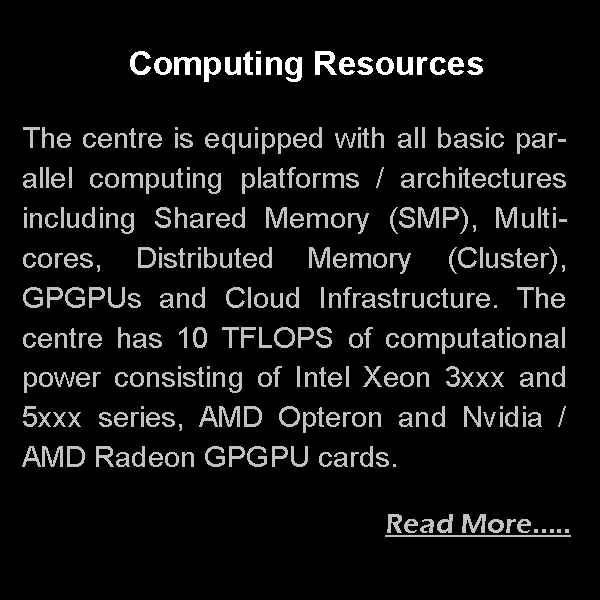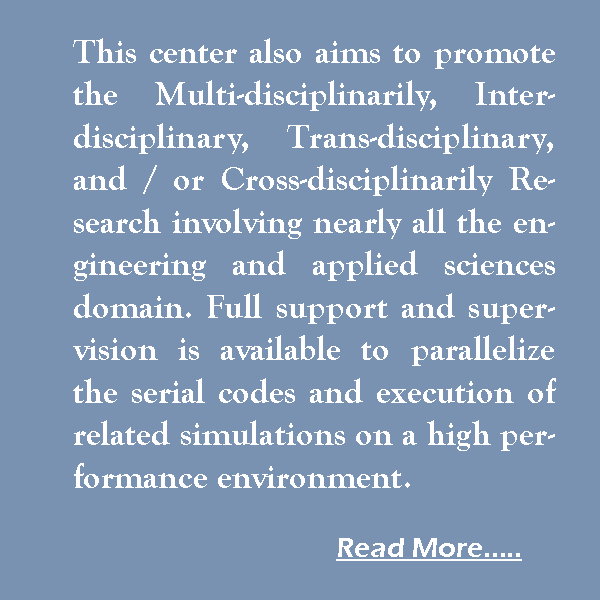This center also aims to promote the Multi-disciplinarily, Inter-disciplinary, Trans-disciplinary, and / or Cross-disciplinarily Research involving nearly all the engineering and applied sciences domain. Full support and supervision is available to parallelize the serial codes and execution of related simulations on a high performance environment.
Besides these, the center also concentrates on supervision and guidance to scholars / professionals of all levels in the related technologies. These include:
- High Performance Computing Architectures and Programming
- Performance Analysis of Parallel Computer Systems
- Cloud Computing
- Cluster Computing
- Distributed Computing
- GP-GPU Computing
- Multicore Architecture and Programming
- Big Data Computing
- Software Define Networking
- Operating Systems Design
- Linux Kernel Debugging
- Software Engineering
HPCC FYPs 2017
Technology |
Students Name |
| Process Scheduling In LINUX | Misbah Afzal |
| Ayesha Aslam | |
| Arooba Jammal | |
| Kernel Optimization For NFV | Nabeel |
| Muhammad Hasnain | |
| Zain Ul Abeden Khan | |
| Disolve A Self-Destructive Data System Based On Dynamic Paswords | M.Waleed Bin Saeed |
| Syed Wasif Murtaza | |
| Mohsin Rafi | |
| Use Of Metaheuristic In Prescriptive Analysis | Farah Sadiq |
| Wajiha Altaf | |
| Bisma Ayaz | |
| Botnet Detection In Cloud Using Aritficial Immune System | Barkat Khan |
| Abroo Jalil | |
| Sania Zafar | |
| Prescriptive Analysis Through Deep Learning | Syed Saeed Ul Hassan Ali |
| Muhammad Waqar Azeem | |
| Muhammad Marib Iqbal | |
| Improved & Optimised Solution For Mutual Exclusion | Ayesha Ali |
| Wajjiha Rizwan | |
| Maha Gul | |
| Real Time Number Plate Recognition Via Deep Learning | Ramlah Ahmed |
| Hareem Arshad | |
| Tooba Siddiqui | |
| Block Chain Architecture On Xeon Phi | S.M.Yasir |
| Misbah | |
| User Activity Analysis Using Unsupervised Deep Learning On LINUX Os | Osama Bin Bashir |
| Muhammad Abdullah | |
| Jaya Rajwani |
HPCC FYPs 2016
Technology |
Students Name |
| MongoDB, OpenStack, Encryption | Sarosh Khalid |
| M.Arbab | |
| S. Faraz Ahmed | |
| Arsalan Shahid | |
| OpenStack, Heat, YAML | Naveed Ahmed |
| Javeria Shabbir | |
| Sheerina Khattak | |
| Aroma Gul | |
| PAAS, IAAS, MongoDB, RESTFUL API | Waseem Ikram |
| Faisal Hyder | |
| Anosha Waseem | |
| Adeena | |
| GPGPU, OpenStack, CUDA, OPENCL | Muhammad Usman |
| Muhammad Yasir Junaid | |
| Syed Saad Ahmed | |
| Erum Rizvi | |
| Web Services, Cassandra DB, Image Processing, Character Recognition | Muhammad Usman |
| Khadija Azam | |
| Fahad Jalal | |
| Owais Shahzad | |
| Software Defined Networking (SDN), Apache Hadoop, Apache Spark, OpenFlow | Tahir Shakil |
| Talha Ghaffar | |
| Asjad Sohail | |
| Wajahat Habib | |
| Pervasive Computing, Semantic Web, OWL, RDF/XML | Anum Afzal |
| Hiba Ahmed | |
| Sheema Masood | |
| Semantic Web, OWL, SPARQL, RDF/XML | Fatima Abdul Ghaffar |
| Hiba Zia | |
| Rehma Lodhi | |
| Docker Engine, Android SDK | Usama Bin Masood |
| Amrat Kumar | |
| Jasim Ahmed | |
| Muhammad Hummad | |
| OpenStack, Hypervisor, NETFLOW | Sonia Ali |
| Yousuf Siddiqui | |
| Syed Muneeb Arif | |
| Marwan Qaiser | |
| Software Defined Networking (SDN), Ostinato, Openflow ,Wireshark | Khalid Ahmed |
| M.Wajahat Shah | |
| Rao Muneeb | |
| Daniyal Saleem |
Some Past Research Project:
Heuristic based Data Fusion using Hadoop Framework (M.Engg Research)
Multi-sensor data fusion is the process of combining observations from a number of different sensors to provide a robust and complete description of an environment or process of interest. It is used to deal with the data uncertainty or data in doubt which is an important dimension of big data known as veracity. In the present era of big data, multi-sensor fusion of such huge amount of data is a nontrivial process which cannot be performed by traditional database tools. This thesis contributes by proposing a heuristic MapReduce based framework for Human Activity Recognition (HAR) on big data. HAR is a significant application of multi-sensor fusion and a promising concept of pervasive computing. Successful recognition of common human activities is the primary objective of HAR. It can be applied to many real-life, human-centric problems such as eldercare and healthcare. The new proposed HAR framework performs the process of activity recognition by Activity Recognition Chain (ARC). ARC involves multiple stages namely, data acquisition & preprocessing, segmentation & feature extraction, feature selection & classification and decision fusion. The REALDISP dataset which is huge in size and fulfilling all the major requirements is employed to perform HAR. After acquiring the desired data, the HAR framework approaches the problem of segmentation & feature extraction by MapReduce programming model which is an innovative concept. Hadoop multi-node cluster is set up to perform segmentation & feature extraction. It can be seen through the results, that it is inappropriate to perform segmentation & feature extraction with lesser number of cluster nodes as it might lead to job failure. The extracted features are then passed through the process of feature selection which is performed by a meta-heuristic known as Genetic Algorithm (GA) in order to remove redundant features which results in higher classification accuracy. Classification stage is the most critical; it is performed after feature selection to categorize multiple activities. Weka machine learning library is used to perform feature selection & classification. The classification results of multiple sensors serve as an input to the final stage of an ARC i.e decision fusion. It is responsible to merge the outcomes of multiple sensors in order to reach a final consensus using a prominent technique known as mean rule. The final results clearly depict how multi-sensor fusion improves the overall classification accuracy of a HAR system. The upgrading of the HAR framework as a Java tool is also a significant contribution of this work. The Java tool is able to provide a user friendly GUI, which makes the framework portable and easy to use for the end user in order to perform HAR in a convenient manner.
Ms. Hameeza Ahmed
Department of Computer & Information Systems Engineering
hameeza@neduet.edu.pk
Research Supervisor: Dr. Muhammad Ali Ismail
Department of Computer & Information Systems Engineering
maismail@neduet.edu.pk
Implementation of chain trust mechanism for enhancing the operational trust in cloud computing (M.Engg Research)
Establishing trust in cloud system is a complex and challenging problem. In cloud computing trust establishment has to be both identity and properties based due to its dynamic nature, complexity of infrastructure, automated services, application interdependencies, and diversity of stakeholders.
Trust in cloud depends mainly upon two factors. One is the operational trust which deals with the operations of cloud service provider and other is automation of different mechanisms for service providers to provide trust. The idea behind this study is the implementation of an open source based cloud. After the implementation of cloud different trust mechanisms should be established at application, virtual and physical layer of cloud in order to enhance the operational trust of cloud.
Mr. Muhammad Faraz Hyder
Department of Computer & Information Systems Engineering
farazh@neduet.edu.pk
Research Supervisor: Dr. Muhammad Ali Ismail
Department of Computer & Information Systems Engineering
maismail@neduet.edu.pk
Study of the Effects of Nitrogen on the Performance of Proton Exchange Membrane Fuel Cell (PEMFC) (PhD Research)
Proton exchange membrane fuel cells (PEMFCs) are efficient and environmentally clean electrical generators that are being developed for both stationary and mobile applications. Reactants in PEMFC are mainly hydrogen and oxygen which are supplied at anode and cathode respectively. Oxygen is generally supplied in the form of air, which contains large amount of nitrogen. Nitrogen can crossover from the cathode side to the anode side through the membrane of the fuel cell. Nitrogen can also enter the anode stream as an impurity with hydrogen fuel. Efficient fuel cell operation requires excess amount of hydrogen and oxidant. Hence there is always some unused hydrogen in the anode exhaust which is recirculated for better fuel economy. Recirculation of anode exhaust thus results in the build-up of nitrogen. Large amount of nitrogen in the anode can affect the performance of the fuel cell. Anode exhaust is therefore purged occasionally. High rate of purging is not desirable because it wastes fuel.
The purpose of the proposed study is to gain an in-depth understanding of the effects of nitrogen on the performance of the PEMFC. The work will include numerical modeling and experimental investigation on nitrogen effects on a fuel cell. The study will also evaluate the differences on the influence of nitrogen on a single cell and a stack.
Ms.Amber Fishan Zafar
Research Scholar
Department of Automotive & Marine Engineering
amberfz@gmail.com
Flexible and Power Adaptive Power Amplifiers for Wideband Transmitters (PhD Research)
A frequency selective and power adaptive broadband amplifier is intended to be designed and fabricated. The frequency within a certain band is selected by means of proper termination at the frequency band. The matching network of the amplifier will be realized by using inherent capacitances of transistors. This gives the dual advantage of having an on-chip matching network as well as reconfigurability by altering the voltage conditions of the transistors emulating the capacitive response.
The adaptive nature of power amplifier will be implemented by using the distributed amplifier topology. The active number of stages of the distributed amplifier will determine the power level of the amplifier while the termination issues arising from switching of stages will be dealt by the adjustment of capacitors.
During the course of work, a number of power amplifiers' circuits will be designed and simulated in Cadence EDA tools. After a successful simulation result, the design will be taped out to a foundry for implementation on a suitable technology node. The design will then be tested for verification and conformance with simulated results. Extensive collaboration with local industry partner (NESCOM) and academia abroad (Linkoping University, Sweden and METU, Turkey) will be done to benefit from each other's experience and results.
A frequency agile, power adaptive broadband power amplifier has applications in many fields including defense, cognitive radio, jamming devices etc. Successful implementation will be attractive for military applications in the country and semiconductor corporations like Ericsson and Infineon.
Mr. Hashim Raza Khan
Research Scholar
Department of Electronic Engineering
hashim@neduet.edu.pk
Research Supervisor: Dr. Qamarul Wahab
Oman IT Chair Professor
quw@neduet.edu.pk
Network performance evaluation of WDM network with OPNET (OPtimized Network Engineering Tool) (M.Engg Research)
This study investigated the problem of assignments in a multiservice SDH/SONET optical network design with network capacity constraint. The algorithm is tested in OPNET simulation environment using different network models derived from a hypothetical case study of an optical network design for Pakistan. Data are collected for analysis from the simulation, and the number and the capacity of nodes and ring are the control variables under investigation. Simulation results for the different network model under uniform and non-uniform traffic demands are reported. The algorithm is able to return a solution with a performance measure that is close to optimal.
Bashir Ahmed Zeeshan
Department of TeleCommunications Engineering
engineerbaz@gmail.com
Waste Water Treatment, Reuse/Disposal at Qasimabad, Hyderabad Sindh (M.Engg Research)
Hyderabad, the second largest city of Sindh province, is situated on the left bank of river Indus, some 170 km in the north of Karachi. It has a population of about 1.8 million. To respond to the rapid increase of urban population in the recent years, the city of Hyderabad has attempted to the means and facilities to maintain the environmental conditions in the urban areas. Here in the city the capacity of treating drinking water, refuse collection and its disposal falls far below the demand. A huge quantity of water is supplied without any treatment. The large volume of solid waste is left and burned in the backyards of buildings, streets and side ditches. Along with all these problems the management of wastewater is also a poorly attended problem in the city where by creating unhygienic conditions, affecting environment and public health.
Main object of the study is to recommend the best options for the treatment, Reuse/Disposal of Waste water at Qasimabad, Hyderabad, Sindh. The project includes four sections. In the First Section the characteristics, sources, treatment options, treatment processes, and different reuse options are discussed. The status of wastewater reuses in Pakistan is also covered. The Second Section includes complete field survey covering untreated wastewater reuse practices and their effects, affected areas, water quality assessment and laboratory analysis are discussed in this section. The Third Section covers the complete information about Proposed wastewater treatment plant by Water & Sewerage Authority/ Hyderabad Development Authority (WASA/HAD) to manage the wastewater of area. And the suitability of the proposed treatment plant is also covered in this section. The Fourth and last Section includes the alternative option and its design for the proposed treatment plant and its suitability supported by the simulation with the help of GPS-X computer.
Syed Ali Sher Shah
Department of Environmental Engineering
alisher168@hotmail.com
The impact of traffic on air quality (M.Engg Research)
This independent study project report includes an extensive literature review of air pollution especially related to traffic. The literature review indicates that CO carbon monoxide is the major traffic pollutant. After choosing a suitable model technique with all parameters that can be easily found out according to our local conditions and that can model carbon monoxide emissions due to traffic and understanding its implementation in MATLAB, a major part of the project is to be accomplished still, that is field observations. The field observations include two major parts first is the traffic volume count at different timings and appropriate chosen days and the second part includes the air quality monitoring of carbon monoxide (CO) concentrations in ppm (parts per million). After all the hectic field observations taken, a proper data sheet is finally drawn. Environmental modeling is defined then the basic equation of Gaussian plume model (basic model of this project) is discussed, and the parameters used in the model are defined. The final model equation is mentioned. Then all the parameters mainly, CO concentrations, traffic composition and others like wind speed along with its direction are modeled using MATLAB in the HPC (High Performance Computing Centre, NEDUET) for predicted traffic volume at specific days in given timings.
Ayesha Alam
Department of Environmental Engineering
sayeshaalam@yahoo.com
Development of a Groundwater Simulation Model for Malir River Basin, Karachi for Sustainable Peri-Urban Water Management (M.Engg Research)
The proposed research study aims at understanding the response of the groundwater reservoirs (aquifers), with the help of definition, development and calibration of a groundwater model for the Malir River Basin (MRB). A groundwater model is a computer-based representation of the essential features of a natural hydrogeological system that uses the laws of science and mathematics.
NED University of Engineering & Technology, Karachi has procured commercial software Visual MODFLOW 4.1 that provides ease in pre-processing and post-processing of MODFLOW (the most widely used software for groundwater modeling). The same will be utilized for the research study in collaboration with High Performance Computing Centre of the university. MRBGWM will be developed and calibrated using Visual MODFFLOW 4.1 in order to prepare recommendations for future exploitation and management of the Karachi Peri-Urban groundwater resources in a sustainable manner.
Hariss Akram Bhatti
Research Assistant Department of Civil Engineering
harisresearch@yahoo.com
Conjugate conduction-convection analysis of finned tube annulus in longitudinal flow (M.Engg Research)
A numerical study of steady state, laminar, single phase conjugate conduction-convection problem for annular finned tube in longitudinal flow will be carried out to demonstrate the effect of fin height-to-pitch ratio on total heat transfer and pressure drop of two unmixed fluid streams in counter flow.
In a concentric tube annulus circumferential fins are often added to increase the heat transfer rate. The addition of fins not only alters the heat transfer rate from the tube but also changes the flow pattern. In a simple annulus heat transfer is mainly dependent on three dimensionless variables, the Reynolds number, the Prantdl number and the radius ratio. However, in a finned tube annulus, one more important parameter fin pitch-to-height ratio is added to the list. Heat transfer and pressure drop are greatly influenced by fin pitch-to-height ratio, small values of the ratio provide more heat transfer area with decreased pressure drop whereas for the larger values of fin pitch-to-height ratios, the fins act primarily as turbulence promoters while increase in heat transfer surface is secondary. Simultaneous analysis of conduction within the fins and convection in the surrounding fluid may provide vital information that could help designers optimize the heat transfer processes in heat exchange devices.
M. SOHAIL HANIF
Junior Researcher, Department of Mechanical Engineering
msohailhanif@yahoo.com




